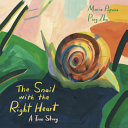2018 School Spending Survey Report
The Snail with the Right Heart: A True Story
Enchanted Lion.
Feb. 2021.
56p.
Tr $18.95. ISBN 9781592703494.
COPY ISBN
VERDICT The romantic and anthropomorphic aspects of the story and explanations will appeal to some adult readers, and some parents and teachers may find this useful for introductory discussions of genetics, diversity, or evolution with children.
RELATED
ALREADY A SUBSCRIBER? LOG IN
We are currently offering this content for free. Sign up now to activate your personal profile, where you can save articles for future viewing





Be the first reader to comment.
Comment Policy:
Comment should not be empty !!!